Paytm Bundle
Can Paytm Conquer Tomorrow's Fintech Frontier?
From its inception in 2010, Paytm revolutionized digital payments in India, evolving from a mobile recharge platform to a financial services powerhouse. Today, with a massive user base, Paytm's journey reflects the dynamic evolution of the Paytm SWOT Analysis. But what's next for this fintech giant?
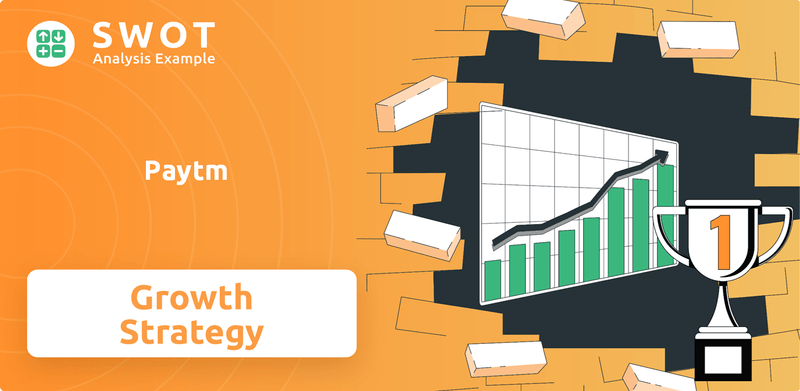
This article dives deep into the Paytm growth strategy, analyzing its Paytm future prospects within the thriving fintech industry Paytm. We'll explore its Paytm company analysis, examining its expansion plans, innovative services, and the competitive landscape of the digital payments India market, providing insights into its potential impact on the Indian economy and the mobile wallet market.
How Is Paytm Expanding Its Reach?
The expansion initiatives of the company are primarily focused on strengthening its foothold in the Indian market and diversifying its revenue streams. This involves a multi-pronged approach, targeting both merchant and consumer segments across various geographical locations, with a special emphasis on semi-urban and rural areas. The strategy leverages the existing user base and infrastructure to introduce and promote a wider array of financial products and services.
A significant aspect of the expansion strategy includes the deployment of more soundbox devices to merchants. These devices provide instant payment confirmations, enhancing the efficiency of transactions and improving the overall payment experience. The company is also heavily invested in expanding its loan distribution business, aiming to provide financial solutions to a broader customer base. This is complemented by the introduction of new products and services within the financial services sector, such as insurance and wealth management offerings.
The company is also continuously enhancing its payment offerings, including UPI (Unified Payments Interface) services, and integrating new features into its platform to improve user experience and engagement. The company is also exploring opportunities in new business models, such as its focus on high-ticket loan distribution as a third-party application provider (TPAP) for UPI payments. While specific international expansion timelines are not prominently detailed in recent reports, the company's primary focus remains on solidifying its position within the Indian market and leveraging its existing user base for cross-selling financial products.
The company is actively expanding its merchant network, particularly in semi-urban and rural areas. This expansion is crucial for increasing the adoption of its payment solutions and financial products. The goal is to onboard more merchants to facilitate digital transactions, thereby driving growth in transaction volumes and revenue.
Increasing the deployment of soundbox devices is a key initiative. These devices provide instant payment confirmations, which enhance the efficiency of transactions for merchants. This expansion helps in improving the user experience and encouraging more merchants to adopt the company's payment solutions.
The company is focusing on expanding its loan distribution business. This involves providing loans to merchants and consumers, thereby diversifying its revenue streams. This strategy aims to capitalize on the growing demand for credit in the Indian market.
The company is expanding its presence in the financial services sector by offering a wider array of products. This includes insurance and wealth management services, which aim to cater to the diverse financial needs of its users. This diversification helps in increasing revenue and customer engagement.
The company's expansion initiatives have shown positive results, particularly in loan disbursals. For the quarter ending December 2023, merchant loans disbursed totaled ₹1,557 crore (approximately $187 million), representing a year-on-year growth of 58%. This growth underscores the effectiveness of the company's strategy in the loan distribution business and highlights its potential for future expansion. You can learn more about the company's Revenue Streams & Business Model of Paytm.
- The company is focused on expanding its merchant network, particularly in semi-urban and rural areas, to increase the adoption of its payment solutions.
- Deployment of soundbox devices is a key initiative to enhance transaction efficiency.
- The loan distribution business is a significant area of expansion, with substantial growth in loan disbursals.
- The company is also expanding its financial services offerings, including insurance and wealth management products.
Paytm SWOT Analysis
- Complete SWOT Breakdown
- Fully Customizable
- Editable in Excel & Word
- Professional Formatting
- Investor-Ready Format
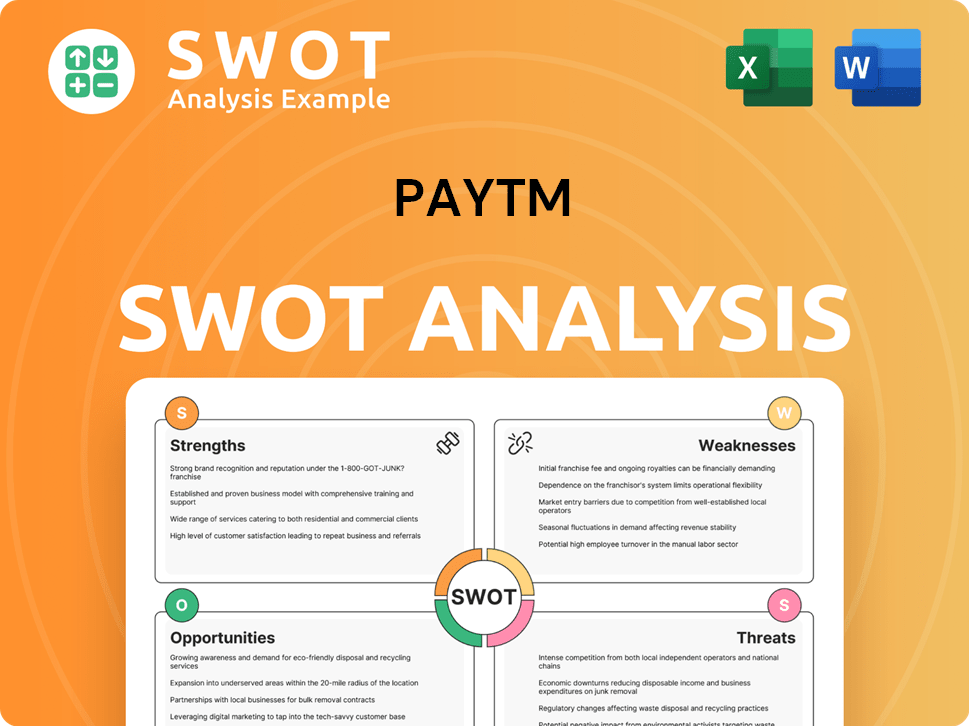
How Does Paytm Invest in Innovation?
The company's growth strategy heavily relies on technological innovation to maintain its competitive edge in the dynamic digital payments landscape. This focus is crucial for expanding its user base and increasing transaction volumes, which are key drivers of its financial performance. The continuous development of new features and services is essential for attracting and retaining customers in the mobile wallet market.
The company's approach to innovation and technology is central to its long-term success. By leveraging cutting-edge technologies, it aims to enhance user experiences, improve security, and expand its service offerings. This strategy supports its expansion plans and helps it navigate the challenges and opportunities within the fintech industry.
The company's future prospects are closely tied to its ability to innovate and adapt to the evolving needs of its users and the market. The company's investments in research and development, particularly in areas like AI and machine learning, are indicative of its commitment to staying at the forefront of digital transformation. This proactive approach positions it well for sustained growth in the digital payments India sector.
The company continuously works to improve its payment infrastructure to make transactions faster, more secure, and more reliable. This involves advancements in its UPI platform and the development of new solutions for merchants and consumers. These improvements are critical for maintaining user trust and increasing transaction volumes.
The company is exploring the use of artificial intelligence (AI) and machine learning (ML) to personalize user experiences, improve fraud detection, and enhance its lending algorithms. These technologies help in providing tailored services and improving overall platform efficiency. This also supports the company's efforts in expanding its loan distribution business, relying on technological platforms for efficient processing and risk assessment.
The company focuses on expanding its soundbox devices and integrating them with its payment ecosystem, showcasing its dedication to providing innovative solutions at the point of sale for merchants. This expansion strategy is vital for increasing its presence in the market and providing merchants with convenient payment solutions. The company's efforts in expanding its loan distribution business also rely heavily on technological platforms for efficient processing and risk assessment.
The company consistently invests in its research and development to enhance its platform's capabilities and introduce new services. While specific details on R&D investments are not always publicly disclosed in real-time, the continuous rollout of new features and improvements to its existing services demonstrates its commitment to technological advancement. The company's strategic partnerships also play a key role in expanding its technological capabilities and market reach.
The company's UPI platform is continuously upgraded to handle more transactions efficiently and securely. These advancements are crucial for maintaining its market share and attracting new users. The focus on UPI is a key part of the company's strategy to drive digital payments India.
The company develops innovative solutions for merchants to facilitate easy and secure transactions. These solutions help merchants manage their businesses efficiently and attract more customers. The company's focus on merchant solutions is a key part of its business model.
The company's technology strategy focuses on enhancing its payment infrastructure, integrating AI and machine learning, and providing innovative solutions for merchants and consumers. These strategies are essential for driving growth and maintaining its competitive edge. For more insights into the company's financial performance, you can explore a detailed analysis of the company's financial performance.
- UPI Integration: Continuously improving and expanding its Unified Payments Interface (UPI) platform to handle more transactions and enhance user experience.
- AI and ML Applications: Utilizing artificial intelligence and machine learning to personalize user experiences, improve fraud detection, and refine lending algorithms.
- Merchant-Focused Solutions: Developing and deploying innovative point-of-sale (POS) solutions, such as soundbox devices, to support merchants and expand its ecosystem.
- R&D Investments: Investing in research and development to introduce new features and services and improve existing offerings.
- Data Analytics: Leveraging data analytics to gain insights into user behavior, optimize services, and make informed business decisions.
Paytm PESTLE Analysis
- Covers All 6 PESTLE Categories
- No Research Needed – Save Hours of Work
- Built by Experts, Trusted by Consultants
- Instant Download, Ready to Use
- 100% Editable, Fully Customizable
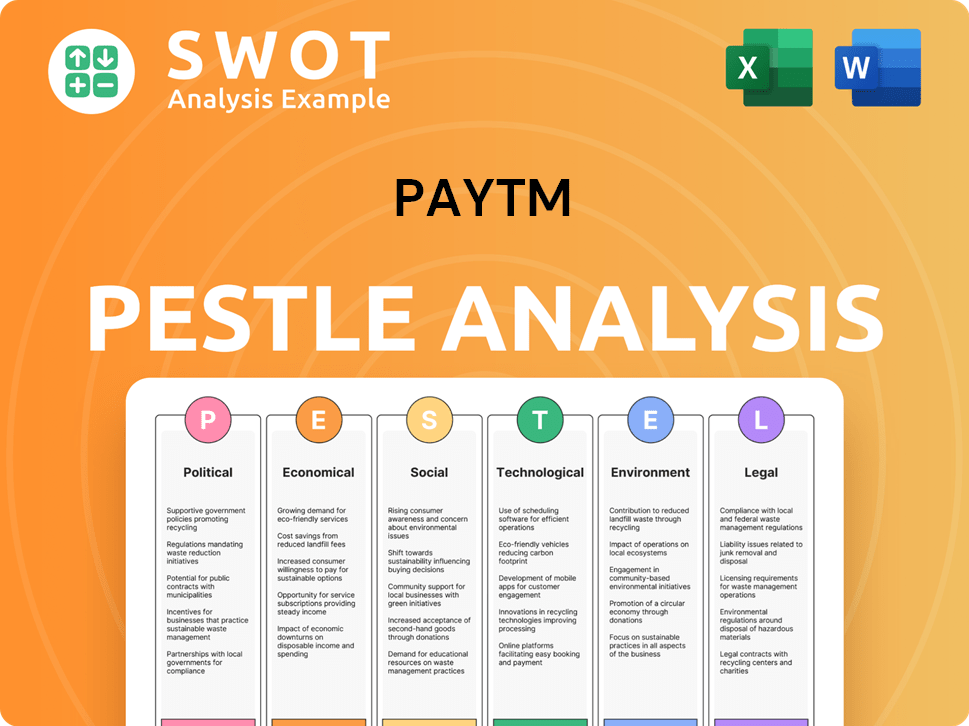
What Is Paytm’s Growth Forecast?
The financial outlook for the company reflects a strategic pivot toward profitability and sustainable operations. This shift follows a period marked by significant regulatory challenges. A thorough Paytm company analysis reveals a focus on adapting to these changes while maintaining core services.
For the quarter ending December 2023, the company's revenue from operations increased by 38% year-on-year, reaching ₹2,850 crore (approximately $342 million). This growth indicates resilience and the effectiveness of its strategic initiatives. The company has been actively working on improving its profitability.
The company's adjusted EBITDA before ESOP reached ₹318 crore (approximately $38 million) in Q3 FY24, a notable increase from ₹200 crore in the previous quarter. This positive trend suggests an improving financial trajectory, demonstrating the company's ability to manage costs and enhance operational efficiency. The company's ability to adapt to market changes is crucial for its long-term success.
The company's revenue from operations grew by 38% year-on-year to ₹2,850 crore (approximately $342 million) in the quarter ending December 2023. This growth highlights the company's ability to expand its business operations. This growth is a key indicator of the company's performance in the digital payments India market.
Adjusted EBITDA before ESOP reached ₹318 crore (approximately $38 million) in Q3 FY24, up from ₹200 crore in the previous quarter. This improvement shows the company's focus on operational efficiency. This is a positive sign for investors looking at the company's Paytm investment potential.
Recent regulatory actions by the Reserve Bank of India (RBI) regarding Paytm Payments Bank have introduced significant headwinds. The restrictions, including a ban on new deposits and credit transactions after March 15, 2024, are expected to affect the company's financial services business. The company is working to mitigate the impact of these regulations.
The company is actively forging new partnerships with other banks for its UPI services and loan distribution. It aims to become a third-party application provider (TPAP) for UPI. These adjustments are crucial for the company's long-term sustainability and growth in the fintech industry Paytm.
Despite these challenges, the company is focused on operational efficiency and ensuring the continuity of its core payment services. The company's Paytm growth strategy includes adapting to regulatory changes and exploring new partnerships. The company's ability to innovate and adapt is essential for its Paytm future prospects. You can read more about the competitive landscape in the Competitors Landscape of Paytm.
Paytm Business Model Canvas
- Complete 9-Block Business Model Canvas
- Effortlessly Communicate Your Business Strategy
- Investor-Ready BMC Format
- 100% Editable and Customizable
- Clear and Structured Layout
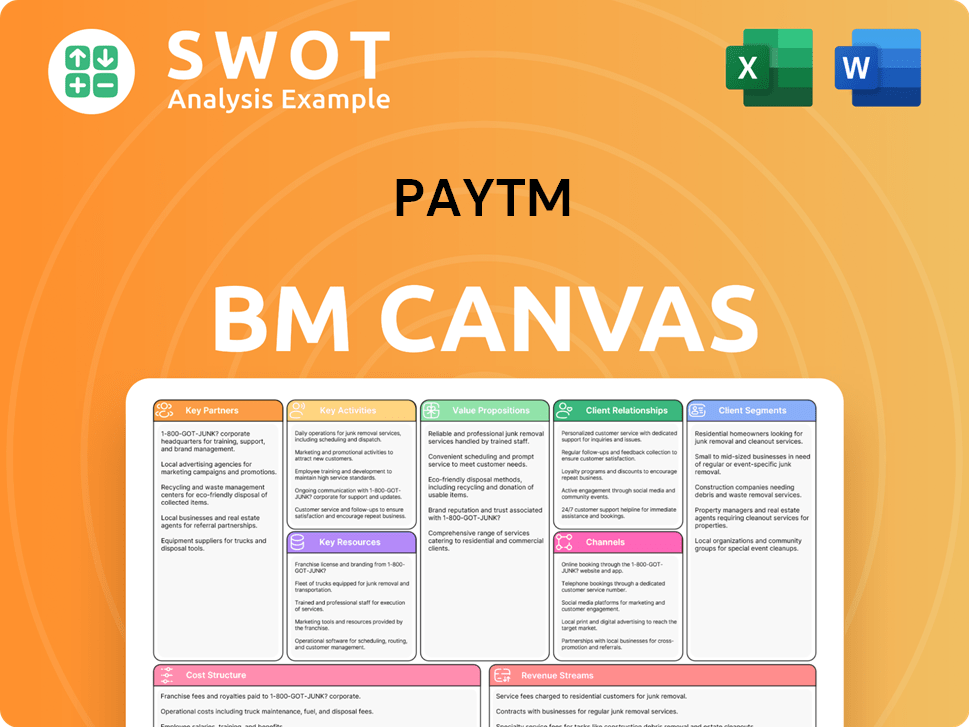
What Risks Could Slow Paytm’s Growth?
The trajectory of the company, and its Paytm growth strategy, is significantly influenced by several key risks and obstacles. Recent regulatory actions, especially those impacting its Payments Bank operations, have introduced considerable uncertainty. Navigating these challenges is crucial for the company's future prospects and long-term viability.
One of the primary concerns revolves around the competitive landscape within the digital payments sector in India. The company faces stiff competition from established players and other emerging fintech companies. Furthermore, the company must constantly adapt to evolving regulations and potential policy shifts, which can significantly impact its business model and operations.
The company's ability to sustain its market position and achieve its financial goals is contingent on effectively managing these risks. This includes strategic partnerships, proactive risk management frameworks, and a keen understanding of the dynamic market environment. This includes understanding the Target Market of Paytm.
The Reserve Bank of India's (RBI) directives have created significant hurdles for the company, particularly concerning its Payments Bank. These restrictions have limited its ability to offer certain financial services, impacting its revenue streams and operational flexibility. The company is adapting to the new regulatory environment.
The Fintech industry Paytm operates in is highly competitive. It competes with major players such as Google Pay and PhonePe, along with traditional banks, all vying for market share. This competitive pressure necessitates continuous innovation and strategic differentiation to maintain and grow its user base.
The rapid evolution of technology presents a risk. The emergence of new payment methods or platforms could potentially disrupt the company's market position. It must continually invest in technology and innovation to remain competitive and meet evolving consumer preferences.
While less direct, supply chain issues could indirectly impact its merchant acquisition efforts. Disruptions in the supply of hardware, such as POS devices or Soundboxes, could affect the company's ability to onboard new merchants and expand its service offerings. The company needs to mitigate these risks.
Operational risks, including cybersecurity threats and data breaches, pose a constant challenge. Protecting user data and maintaining system integrity are crucial for maintaining trust and ensuring the smooth operation of its services. Robust security measures are essential.
Financial risks, such as fluctuations in interest rates and currency exchange rates, can impact the company's profitability. Managing these risks requires careful financial planning and hedging strategies. It is important for the company to have a strong financial foundation.
To counter these risks, the company is diversifying its partnerships, collaborating with Axis Bank, HDFC Bank, and Yes Bank for its UPI services. This reduces reliance on a single entity. The company is also focusing on its role as a third-party application provider (TPAP) for UPI, aiming to leverage its extensive user base.
The company is actively engaged in scenario planning and developing robust risk management frameworks. This proactive approach helps the company navigate the evolving regulatory and competitive landscape. Continuous innovation and adaptation are key to its long-term success.
Paytm Porter's Five Forces Analysis
- Covers All 5 Competitive Forces in Detail
- Structured for Consultants, Students, and Founders
- 100% Editable in Microsoft Word & Excel
- Instant Digital Download – Use Immediately
- Compatible with Mac & PC – Fully Unlocked
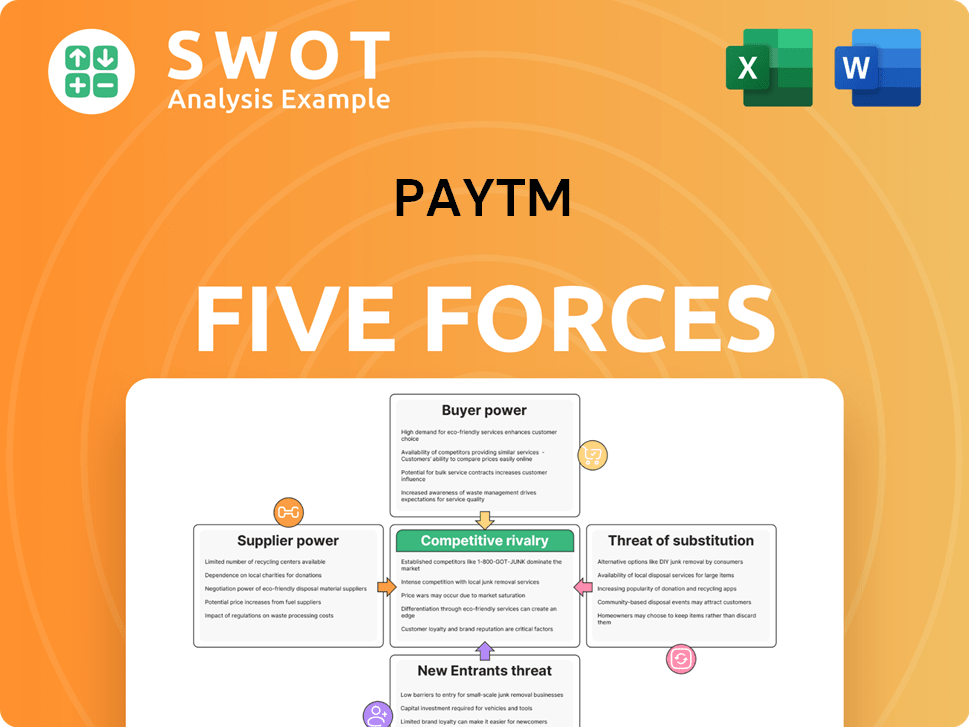
Related Blogs
- What are Mission Vision & Core Values of Paytm Company?
- What is Competitive Landscape of Paytm Company?
- How Does Paytm Company Work?
- What is Sales and Marketing Strategy of Paytm Company?
- What is Brief History of Paytm Company?
- Who Owns Paytm Company?
- What is Customer Demographics and Target Market of Paytm Company?
Disclaimer
All information, articles, and product details provided on this website are for general informational and educational purposes only. We do not claim any ownership over, nor do we intend to infringe upon, any trademarks, copyrights, logos, brand names, or other intellectual property mentioned or depicted on this site. Such intellectual property remains the property of its respective owners, and any references here are made solely for identification or informational purposes, without implying any affiliation, endorsement, or partnership.
We make no representations or warranties, express or implied, regarding the accuracy, completeness, or suitability of any content or products presented. Nothing on this website should be construed as legal, tax, investment, financial, medical, or other professional advice. In addition, no part of this site—including articles or product references—constitutes a solicitation, recommendation, endorsement, advertisement, or offer to buy or sell any securities, franchises, or other financial instruments, particularly in jurisdictions where such activity would be unlawful.
All content is of a general nature and may not address the specific circumstances of any individual or entity. It is not a substitute for professional advice or services. Any actions you take based on the information provided here are strictly at your own risk. You accept full responsibility for any decisions or outcomes arising from your use of this website and agree to release us from any liability in connection with your use of, or reliance upon, the content or products found herein.